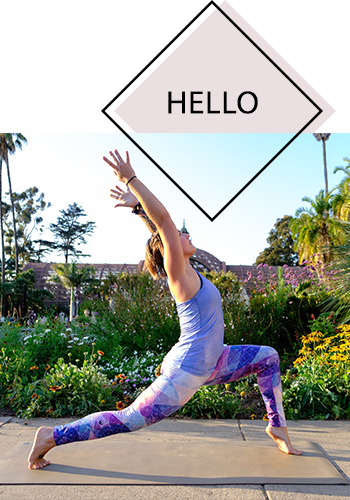How to Calm Your Nervous System in Everyday Life
/You can have the steadiest yoga practice in the world and still get thrown off by everyday life.
You can roll up your mat feeling centered and grounded after a class… and then ten minutes later, your phone buzzes, someone cuts you off in traffic, or your kid refuses to put on their shoes, and poof, your calm disappears.
Sound familiar? You’re not alone. You’re not doing life wrong. You’re just human.
And in today’s fast-paced, chaotic world filled with negativity and urgency culture, we have to be more mindful than ever in order to care for our nervous systems.
I’ve been thinking about this a lot in the context of how I help authors calm their nervous systems throughout the process of writing and publishing a book.
It’s also a topic that anyone can benefit from learning about, whether or not you practice yoga.
Even if you know all about deep breathing, mindfulness, and the importance of slowing down, life has a way of testing that knowledge daily. Nervous system regulation is about noticing when you’re not and knowing how to find your way back.
Keep reading to the end of this post to get a copy of the nervous system regulation guide I created for you. It’s great to have handy on your phone or printed out and on your fridge for reminders throughout the week!
Why Nervous System Regulation Matters
Your nervous system is your body’s built-in alarm and recovery system. When something stressful happens, your body goes into a fight or flight state (or sometimes freeze, flop, or fawn). That’s your physiology working exactly as it should. It’s trying to protect you.
First recognizing that you’re doing nothing wrong is a great way to approach self-care with an open mind and a gentleness toward yourself.
The thing is, your body doesn’t always know the difference between real danger and modern-day stress. A traffic jam, a harsh email, or an awkward conversation can trigger the same survival response as an actual threat.
When that happens, your heart rate spikes, your breath shortens, your muscles tighten, and your mind races. If that state lingers too long, it can leave you feeling anxious, reactive, or burned out.
That’s why learning how to calm your nervous system is so powerful—it helps you return to safety, clarity, and ease more quickly.
Recognizing Your Stress Response (Fight, Flight, Freeze, Flop, or Fawn)
Start by noticing what’s actually happening in your body. The goal here is simply to become aware. Name it.
Fight – You might feel irritated, impatient, or on edge. You want to argue, control, or “fix” things right now.
Flight – You feel anxious, restless, or distracted. You suddenly have 20 tabs open and can’t stop moving.
Freeze – Everything feels too much. You feel foggy, shut down, or unable to decide what to do next.
Flop – You feel totally drained, like you’ve hit a wall. It’s hard to care about anything.
Fawn – You feel the need to please others or make peace, even at your own expense.
The more fluent you become in reading your own body cues, the quicker you can respond with care instead of judgment.
Simple, Science-Backed Tools for Calming Your Nervous System
Here are a few techniques to try the next time life throws you off balance:
1. The Physiological Sigh
Two quick inhales, one long exhale. This simple breath pattern signals your brain that it’s safe to relax and helps lower cortisol fast. Learn more about it by listening to the Huberman Lab podcast episode on breathwork.
2. Orienting
Look around the room and name five things you can see. This grounds you in the present moment and reminds your brain: “I’m safe right now.”
An alternative to this is to use the 5, 4, 3, 2, 1 grounding technique. Name five things you can see, four things you can hear, three things you can feel, two things you can smell, and one you can taste. Doing this brings you back into the present moment. (Read more about the 5-4-3-2-1 technique here.)
3. Movement and Shaking
When stress energy builds, your body needs a way to discharge it. Dance, walk, shake out your hands, or stretch for 30 seconds. Think of it as an emotional reset button. (Read more about how shaking helps heal trauma or watch this 7-minute video on shaking to guide you through a practice.)
4. Self-Havening or Touch
Gently rub your upper arms, face, or shoulders. This kind of touch releases calming chemicals in the brain and supports emotional regulation. (Try 10 minutes of self havening with this simple video.)
5. Cold Water
Splash your face with cold water or place your wrists under running water. This activates the vagus nerve, helping to reset your parasympathetic system—the part responsible for rest and recovery. (This study on how cold water on the face reduced stress symptoms is so interesting!)
6. Get Outside
Being in nature has a natural healing effect. I love this article: Nurtured by nature. It talks about how being in nature improves mood, mental health, and emotional wellbeing. I know personally whenever I’m under the trees or around water or animals, it really helps me ground and feel grateful.
Nervous System Regulation in Everyday Life
Here are a few real-life examples of what this looks like:
In traffic: Instead of gripping the steering wheel and fuming, take three slow exhales. Feel your back against the seat.
During conflict: Pause before responding. Place a hand on your chest and breathe into your heart space.
At work: Notice when your shoulders are tight. Roll them back. Stretch your neck. Unclench your jaw. You could also gently massage your temples or earlobes.
After doom-scrolling: Set your phone down, look around the room, and focus on one thing you see. Notice your feet on the floor. Take a few deep breaths, slowing your exhales.
These tools are simple, but not easy. It’s all about finding what works for you and what helps you come back to calm, again and again.
The Yoga Connection
If you practice yoga, you already know the power of breath and body awareness. Nervous system regulation is simply applying that awareness off the mat.
It’s how you meet the rest of your life: the messy parts, the stressful moments, the everyday chaos.
Every time you take a conscious breath instead of reacting, every time you notice tension and choose to soften, you’re rewiring your brain for peace. That’s yoga in action.
A Free Resource to Help You Regulate
If you’d like something simple to keep on your phone or print for your desk, I created a free Nervous System Regulation Quick Reference Guide.
It includes:
Quick tools to calm your body in each stress state (fight, flight, freeze, flop, and fawn)
Simple breathwork and grounding techniques
Gentle journal prompts for reflection and release
Download it here: Get the Nervous System Regulation Guide (PDF)
Think of it as a pocket-sized companion for the moments when life feels like too much.
Final ThoughtS
Peace is available to you in any given moment. When we take radical responsibility for caring for ourselves, and we equip ourselves with nervous system regulation tools, it can make such a big difference in our day-to-day experience.
I hope this post and the PDF download help you find more peace throughout the week ahead. You deserve it!
Keep breathing through it.
Much love,
Rachel
P.S. Are you on my email list? Subscribe to the Alive in the Fire newsletter now to get helpful information like this delivered to your inbox every month.













Memoir ghostwriting is about transforming your life in the process of writing a beautifully-crafted book. Here’s why my clients often say the healing becomes the most valuable part.